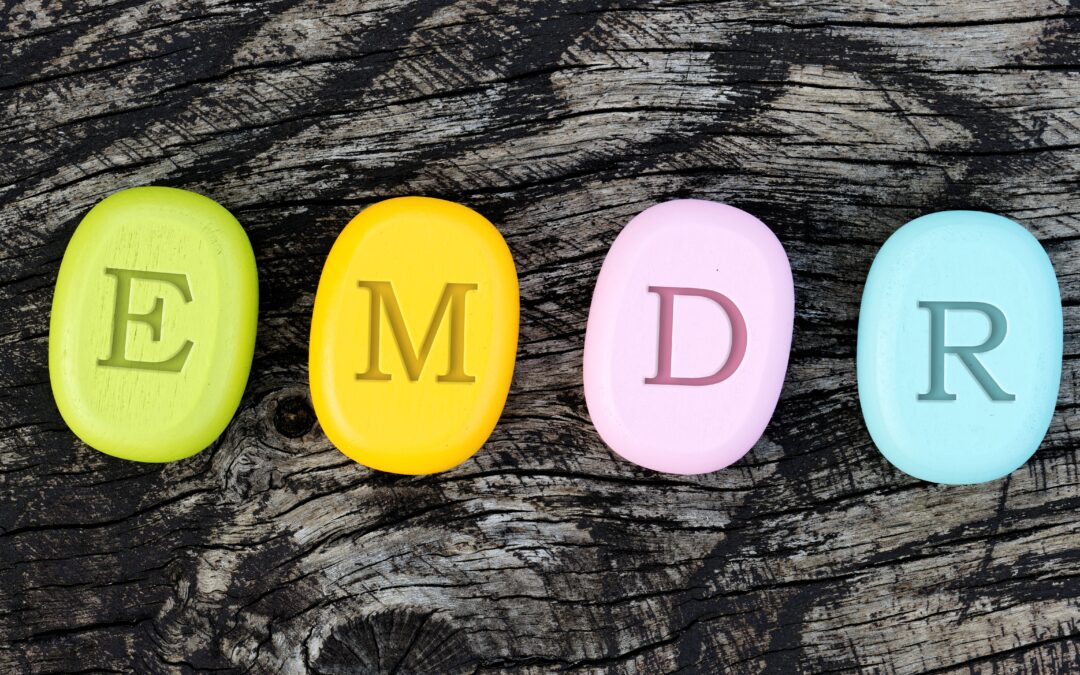When people hear about Eye Movement Desensitization and Reprocessing (EMDR), they often imagine the most visible part of the process: a therapist guiding eye movements or tapping while a client recalls painful memories. What is less visible, but just as essential, is what happens before that stage. EMDR isn’t simply about diving into traumatic memories; it’s about preparing the nervous system to handle the intensity of that work. That preparation is called resourcing.
As an integrative therapist, I often describe resourcing as building the roots of a tree before a storm. If the roots are shallow, the storm may tear it down. If the roots are deep and strong, the tree can bend and sway but remain standing. Resourcing is about strengthening those roots so that when the winds of trauma memories blow through, the system can remain steady.
This blog explores EMDR resourcing through a clinical and integrative lens – why it matters, how it works, the standard techniques, and the barriers some clients face. I will also show how resourcing connects with polyvagal theory, attachment repair, somatic awareness, and holistic wellness.
What Exactly Is EMDR Resourcing?
In the simplest terms, EMDR resourcing is the phase of therapy where clients learn and practice coping strategies, grounding exercises, and imagery that help them feel safe and stable. These “resources” can be drawn upon when distress arises, either in or outside of the session.
But resourcing is more than a toolkit. It is the act of rewiring the nervous system to recognize safety. Trauma, negative experiences, and negative cognitions narrow the body’s ability to tolerate stress and anxiety. Clients often experience a fluctuation between hyperarousal (characterized by panic, rage, and restlessness) and hypoarousal (manifested as numbing, shutdown, and dissociation). Resourcing gently expands the window of tolerance, so clients can remain present while engaging in the difficult work of trauma and negative experience reprocessing.
From a clinical perspective, resourcing also strengthens access to adaptive neural networks which are memories of support, resilience, or strength. This can balance and integrate traumatic and damaging cognitive networks once bilateral stimulation begins.
Why Resourcing Matters
One of the greatest risks in trauma therapy or processing negative experiences is retraumatization. This is where a therapist or other healing professional asks clients to revisit overwhelming material without adequate preparation. Resourcing helps to be a safeguard against this.
Key Functions of Resourcing
- Stabilization – Clients learn to regulate arousal before they approach traumatic material or negative life experiences.
- Affect Regulation – They gain the ability to soothe themselves when emotions surge.
- Attachment Repair – Resource figures offer corrective relational experiences that may have been absent in childhood.
- Somatic Safety – Clients reconnect with the body as a place of grounding, rather than threat.
- Empowerment – Resourcing shows clients they have tools within themselves, counteracting helplessness.
- Therapeutic Trust – The process reinforces that the therapist will not push them unprepared into trauma.
Theoretical Frameworks of EMDR Resourcing
Adaptive Information Processing (AIP) Model
EMDR is built on the AIP model, which posits that trauma remains “stuck” in maladaptive memory networks. Resourcing strengthens adaptive networks, ensuring that once bilateral stimulation is introduced, traumatic material can link with experiences of safety, support, and resilience.
Polyvagal Theory
Dr. Stephen Porges’ polyvagal theory offers a biological explanation. Trauma often traps individuals in survival states – fight, flight, freeze, or fawn. Resourcing activates the ventral vagal system, the branch of the nervous system associated with safety, curiosity, and connection. Each time a client accesses a safe place or a nurturing figure, they are practicing a return to regulation.
Attachment Theory
For those with attachment wounds, resourcing introduces new relational templates. Imagining a nurturing or protective figure enables clients to internalize care they may have never received, thereby repairing deficits in the attachment system.
Somatic and Neurobiological Basis
Resourcing also works somatically. Exercises like the container or the light stream help clients feel sensations of safety in the body. This strengthens interoception (awareness of internal states) and helps clients ground in the present moment.
Common EMDR Resourcing Techniques
There are several well-established strategies used in EMDR resourcing. Each serves a unique function, but all share the goal of providing stability and safety.
- Safe or Calm Place – Clients are guided to visualize a place where they feel peaceful. This might be a beach, a forest, or a cozy chair by a fireplace. Sensory detail is emphasized – what they see, hear, smell, and feel. Bilateral stimulation may be added to reinforce the felt sense of calm. This is the most common one I use with clients.For some clients, “safe” may feel foreign, so I often start with a “calm place,” which can be less triggering.
- Light Stream Technique
I guide clients to imagine a stream of light flowing through the body, releasing tension or discomfort. This can be particularly powerful for clients with somatic trauma symptoms such as chronic pain. This works great for some clients – and some other clients don’t like to practice this one.
- Resource Development and Installation (RDI)
RDI uses bilateral stimulation to install positive memories of resilience or competence. For example, recalling a time when the client successfully overcame a challenge helps integrate a sense of strength that can later balance trauma processing.

- Nurturing, Protector, and Wisdom Figures
Clients imagine figures that embody comfort, protection, and guidance. These may be real people, fictional characters, animals, or spiritual beings. The figures provide corrective relational experiences and are especially valuable for clients with attachment wounds.
- Container Exercise
Clients imagine a secure container where intrusive thoughts or memories can be stored until they are ready to work with them. This gives clients agency over their material and prevents overwhelm.
Potential Barriers to Resourcing
Not all clients find resourcing straightforward or helpful. Some of my clients, after we discuss resourcing, find it doesn’t resonate with them. We may briefly create a calm space, but I find my clients know themselves well, and we only use calm space if it makes sense during the later phases in EMDR.
An integrative approach enables me to adapt, drawing from mindfulness, somatic practices, the creative arts, or even spiritual traditions until something resonates and creates a unique way for my clients to benefit from resourcing in a nontraditional manner. Some common challenges include:
- Difficulty Visualizing – Clients who are not naturally visual may struggle with imagery. Alternative approaches may utilize sound, touch, or body-based grounding techniques.
- Attachment Resistance – Clients with relational trauma may reject nurturing figures or “safe” imagery. In these cases, it helps to start with non-relational anchors.
- Dissociation – Clients may “go blank” during exercises. Grounding in the present moment and keeping exercises brief can help.
- Self-Judgment – Some clients dismiss exercises as “silly.” Normalizing the process and emphasizing practice helps reduce resistance.
- Negative Associations – Sometimes imagery meant to be soothing triggers trauma memories (e.g., a bedroom may not feel safe to a survivor of abuse). Flexibility is key.
Integrative Approaches to Resourcing
From a holistic perspective, resourcing isn’t limited to EMDR protocols. It extends into daily life and draws on multiple domains:
- Biological: Supporting regulation through breathwork, movement, nutrition, and sleep.
- Psychological: Using journaling, cognitive reframing, or mindfulness as daily anchors.
- Relational: Strengthening connections with safe, supportive people outside of therapy.
- Spiritual: Incorporating prayer, meditation, ritual, or a sense of higher meaning if aligned with the client’s beliefs.
A Clinical Example
 One client I worked with struggled with the concept of a “safe place” (which is common for a lot of my clients). I use the words “calm place instead”. Every attempt at visualization felt contaminated by memories of danger. For her, safety was not really a concept she could relate to. Instead of pushing, we began with something more neutral. She remembered sitting on a small boat dock at her childhood neighbor’s lake house and noticing the texture of the solid wood and the flowing, calming presence of the water. That became her anchor.
One client I worked with struggled with the concept of a “safe place” (which is common for a lot of my clients). I use the words “calm place instead”. Every attempt at visualization felt contaminated by memories of danger. For her, safety was not really a concept she could relate to. Instead of pushing, we began with something more neutral. She remembered sitting on a small boat dock at her childhood neighbor’s lake house and noticing the texture of the solid wood and the flowing, calming presence of the water. That became her anchor.
Later, she developed a protective figure in the form of an eagle, which she described as strong, watchful, and intelligent. With bilateral stimulation, her nervous system encoded the eagle and dock as symbols of strength and safety. Over time, she carried them into her daily life, using them to ground herself in moments of anxiety and conflict.
By the time we began trauma reprocessing, she had built enough trust in her inner resources to approach memories without collapsing into overwhelm. The eagle and the boat dock were no longer just images; they were lived experiences of safety that she could return to.
Resourcing Beyond the Therapy Room
What excites me about resourcing is that it extends far beyond EMDR sessions. Once a client has practiced a calm place or learned to call on an inner protector, these tools can be used in daily life. A calm place can become a grounding strategy before a stressful work meeting. A container can help someone pause intrusive thoughts before bed. A nurturing figure can soften self-criticism in moments of shame.
Resourcing is not just about preparing for trauma and negative experience processing; it’s about teaching clients to carry safety with them.
Final Thoughts
EMDR resourcing is more than a set of preparatory exercises; it is the heart of trauma-informed care. It helps clients develop anchors of safety, expands their capacity to tolerate distress, and ensures that healing happens within a window of resilience rather than retraumatization.
From an integrative therapist’s perspective, resourcing is a whole-person practice. It engages the body, mind, relationships, and even the core self-dimensions of healing. It requires creativity, flexibility, and a deep sense of attunement. And most importantly, it reminds clients that healing is not just about revisiting the past, it is about cultivating safety and strength in the present.
If you have any questions regarding EMDR, EMDR Resourcing or Trauma Therapy, please contact me today for a free phone consultation utilizing my online scheduler.



